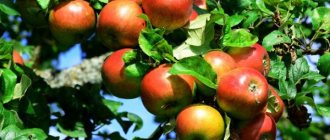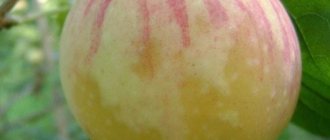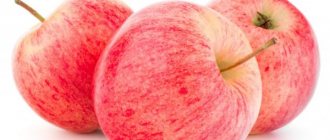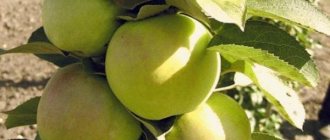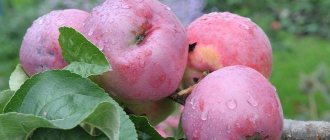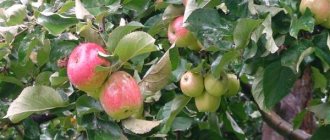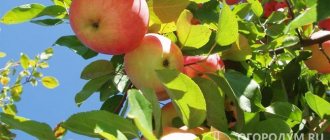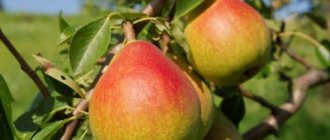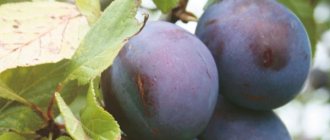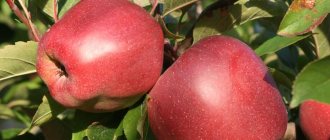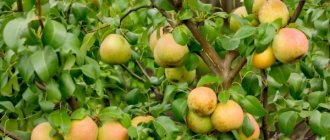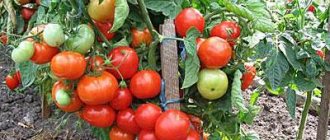How to preserve apples in winter?
Experienced housewives store apples for the winter as follows.
Clean boxes made of wooden slats are prepared in advance, with wide slits so that the fruits can breathe and ventilate freely.
After this, each apple is individually wrapped in newsprint. Newspapers should not be freshly printed, as fresh printing ink will stain the fruit.
It should be remembered that apples of this variety are covered with a natural waxy film, so newspapers with dried paint will have a gentle effect on the thin skin.
A piece of newspaper, the size of which is suitable to envelop the apple from all sides, should be thoroughly crushed before wrapping it around the fruit. Each apple, therefore, should be wrapped in a loose, breathable nest of paper.
If someone has other blank paper that is light, thin and flexible enough, you can use that.
All the fruits, wrapped in their nests, are carefully placed in boxes, layer by layer. Boxes filled to the top should be placed in the cellar, where the temperature is kept between +4 - +10 degrees Celsius.
If you do not have a cellar, then boxes of apples can be placed on the balcony, wrapped in tightly quilted thick blankets, keeping them from frost. Apples wrapped in this way are preserved until spring.
Why this storage method is justified:
- because the thin skin characteristic of this variety is not damaged;
- if one apple rots, the neighboring fruits will remain untouched by rot, because the paper will not allow mold to penetrate them.
A small amount of apples can be stored in the refrigerator at a temperature of +4 degrees Celsius, where they are stored until January without loss of taste and nutrients.
What amateur gardeners say
“Apples of this variety have a good taste, slightly sour. One of the trees in our garden is already old, more than 20 years old, but there are fruits every year. However, you have to remove them very carefully, with caution, since the skin is quite easy to dent.”
“I grow this variety of apples among other apple trees, but this is what everyone in the household loves. The fruits are very tasty, tender in taste and juicy. I place apples in the cellar for storage. I wrap each fruit in paper and carefully place it in a wooden box. The apples will last until the New Year holidays.”
“The magnificent and tasty variety of dessert apples “Orlovsky striped” will make your table richer. This apple variety grows almost everywhere in Russia. For the winter they are stored in dark cellars, having previously been wrapped in a simple newspaper. From them you can make a large variety of preparations for future use for the winter.
Pollination
Experiments carried out at the testing station showed that this variety is practically self-sterile.
In other words, this apple tree has almost no self-pollination.
To improve the harvest, it is recommended to plant Antonovka next door.
Its proximity gives the highest crop growth.
Quite high results are also marked by the presence of:
- Apple trees Orlik;
- Welsey;
- Memory of the Warrior.
Pollination by these varieties produces an ovary in 85% of cases.
The following are planted as acceptable pollinators:
- North Sinap;
- Autumn Striped.
Description of the variety Orlovsky striped
The tree of this variety is of medium height. The crown is extensive, round, with thick, flexible branches at the ends. The branches forming the crown extend at an angle of 90 degrees from the main trunk.
Trees in the middle zone tolerate frost well and have good yields.
Some apples are located on ring-shaped shoots grown on three-year-old branches. Others are placed on flexible two-year-old twigs. Branches are either growth or fruit-bearing.
The trees stretch up to 15 m, have a well-branched root system, and go 2.5 m deep.
The branches have large, convex buds. The leaves often grow, round in shape, with teeth along the edges, pubescent, growing thicker towards the end of the branches, on strong petioles, and deviate from the stem at a slight angle.
Large snow-white, cup-shaped flowers with soft pink buds adorn the tree in the spring, like a bride’s veil. The petals on the flowers are concave, round, and overlap each other at the edges. The powerful pistil is surrounded by stamens. The stigma of the sticky pistil is located just above the loose anthers.
The apples are large, painted with crimson-red stripes on a salad base background and noticeably lighter dots under the skin. During the period of full maturity, the main tone becomes yellowish. These apples are pleasant to the taste, sweet and sour and surprisingly aromatic. The pulp of apples is tender, white or pinkish, even creamy, fine-grained.
The stalks are short, straight, thin. The funnel is pointed and shallow. A deep saucer, with a slightly ribbed wall, the cup is closed, sometimes open. The heart is large. The seed chambers are open, the seeds are dark, indistinct in shape, and sometimes underdeveloped.
The shape of apples is round, slightly elongated, reminiscent of a trimmed cone or an ideal bun with a stem. The stalk is strong and brownish in color. The skin is thin, delicate, covered with a thin matte layer of natural wax. Requires careful handling during collection and storage for long-term storage.
The fruits begin to ripen by the beginning of September, although some gardeners classify it as late autumn. The average fruit weight is from 120 to 150 grams.
What is characteristic of this variety?
Before growing a crop, you should familiarize yourself with the key characteristics of trees and fruits.
External parameters
The apple tree of this variety has a number of distinctive features. They are worth studying before planting.
Apple tree height and crown width
The tree reaches 5 meters in height. It is characterized by a round crown of medium density. Its width can reach 4.5 meters.
Dimensions and branching of the root system
The tree is characterized by powerful branched roots. They are of a rod type and go 1.5 meters deep.
Description of leaves, flowers and fruit
The tree is characterized by large, ovoid leaves. They have a glossy surface. The white and pink flowers are large in size and resemble a saucer.
The fruits are characterized by a round-conical shape and can weigh 150 grams. Ripe apples have a green-yellow color.
All about productivity
The plant is characterized by good productivity. From 1 hectare it is possible to collect 200 centners of fruit. Trees 7-8 years old bear 40-50 kilograms of fruit. From 10-15 year old apple trees it is possible to get 60-80 kilograms of harvest.
See also
Description, characteristics and history of selection of the Bratchud apple tree, planting and careRead
Pollinator varieties
Varieties such as Slavyanka, Titovka, and Striped Anise are suitable as pollinators. These also include Papirovka, Autumn Striped.
Beginning of the first fruiting
This variety begins to produce crops 4 years after planting.
Fruit ripening time
Flowering of trees begins in April or May. In this case, the harvest ripens by early autumn.
Collection and processing
Apples have a delicate skin, so they should be picked in early autumn. Fruits can be stored for 4 months in the refrigerator. Fruits are suitable for any preparations - jams, preserves, juices.
Frequency of fruiting
Young apple trees produce a harvest every year. Over time, they can bear fruit in a year.
Tasting evaluation of apples
Apples have a sweet and sour taste. According to the tasting scale, they are rated 4.6 points.
Winter hardiness
The trees are highly resistant to frost.
Disease resistance
Apple trees of this variety are characterized by resistance to scab.
Lifespan
The tree can live up to 40 years.
Photo
Below in the photo you can clearly see the fruits of the Orlovskoe Polosatoye apple tree:
Features of growing the variety in the regions
In outskirts of Moscow
The seedling is placed on the site at the end of September.
In the Urals
In the Urals, the tree is grown in stale form.
In the Urals, the Orlovskoe striped one is formed into stale.
In the Leningrad region
The Leningrad region has rather poor soils, so before planting they need to be carefully prepared and fertilized.
The variety in the Leningrad region is best planted in a sunny place , maximally protected from the winds, and a winter -hardy skeleton-forming rootstock is used.
History of selection
The unusual apple variety “Orlovskoe striped” was obtained in 1957 by hybridization at the All-Russian Research Institute of Pedagogical Plants of Mekintosh and Bessemyanki Michurin by Russian breeders E.N. Sedov and T.A. Trofimova. In 1967, the variety was recognized as elite.
The natural habitat of this variety is the Baltic humid countries. Therefore, it does not tolerate drought well. However, it received great recognition at international exhibitions in Germany. The variety is considered to be of average winter hardiness. Like other early varieties, flower buds can be damaged by spring frosts.
Origin of culture
Oryol striped apple tree
Orlovskoye Polosatoye is a fast-growing variety with late-autumn ripening apples. The culture was bred at VNIISPK (All-Russian Scientific Research Institute for Selection of Fruit Crops) in 1957. The originators of the form were agricultural scientists T. A. Trofimova and E. N. Sedov.
Breeders obtained the hybrid by crossing:
- apple tree McIntosh (McIntosh), a popular frost-resistant American variety with autumn-winter ripening periods;
- a culture of domestic origin, Bessemyanka Michurinskaya, known for its tasty fruits and high yields.
In 1967, the uniform was recognized as elite. In 1970, the Oryol striped began to undergo testing. In 1986, based on its results, the form received variety status and was registered in the Russian State Register of Breeding Achievements.
The Oryol striped fish is officially zoned in the following regions of the Russian Federation:
- Central;
- Central Black Earth;
- Srednevolzhsky;
- Northwestern;
- Volga-Vyatka.
This variety is high-yielding
- early fruiting - the first fruit ovaries are formed already in the fourth year after planting;
- the crop has an excellent presentation and excellent taste;
- high resistance to the most common disease - scab;
- the yield indicators are high - from one mature tree you can remove from 60 to 80 kg of juicy and tasty fruits;
- Compared to other varieties, the fruits of this tree have good shelf life and can be stored until January at a temperature of 1-2° in the refrigerator, cellar or basement.
READ MORE: Wyandotte chicken breed description, characteristics, disease conditions and prevention
This fruit crop has several disadvantages:
- the fruits have a very delicate and thin skin, so harvesting should be done carefully so as not to damage their integrity;
- poor tolerance to dry climate conditions;
- high risk of kidney freezing during late autumn frosts.
Productivity
Typically, this tree begins to bear fruit in the 4th year of life, but regrafted specimens begin to bear fruit already in the 3rd year.
In the seventh year, one tree produces from forty to fifty, by the fifteenth year up to eighty kilograms of apples, which is up to 200 centners per hectare.
The apple tree is considered early-bearing and high-yielding, harvesting occurs once a year.
Landing
A three-year-old seedling, 1.6-1.8 meters high, with a closed root system, is ideal for planting. They sell seedlings 3, 5 and 7 years old.
Trees are planted in the spring, before the buds open or in the fall. Before the onset of severe cold weather, the seedling must have time to take root, so two or three months must pass.
They say that a tree planted in the fall takes root better; in non-black soil areas, they prefer to plant in the spring.
You should prepare the pit in advance. If planting in spring, dig a hole in autumn. For autumn planting, the planting site is prepared in the summer, no less than 30 days in advance.
The Orlovskoye Polosatoye variety thrives in fertile, moist, well-drained soil. But it is impossible to plant a tree where groundwater is close to it.
Dimensions of the recess for planting:
- diameter 1 meter;
- depth 80 is not less than centimeters.
Planting nutritional composition:
- forest soil;
- organic fertilizers;
- mineral.
Fill the hole by a third with a well-mixed nutrient mixture. Form a small cone in the hole, on which carefully plant the seedling, straightening the roots carefully in a circle, to the base of the cone and the bottom of the hole.
Sprinkle the roots with soil mixed with humus and water them generously, then add the remaining soil on top. You can also water from above, right at the trunk.
The root collar should not be buried in the soil; leave it 6 cm above the soil.
The following can be used as fertilizers:
- compost (2 buckets per 1 seedling);
- wood ash (1 kg);
- superphosphate (see instructions);
- last year's manure.
It is not recommended to add nitrogen fertilizer when planting; it slows down the survival rate of trees.
The gap between rows of vigorous trees is about 6 meters, between seedlings - 4 meters. Small trees are planted closer.
Attention! Apple trees thrive in soil with an acidity of no higher than 6 pH. If the acidity in the garden is higher, dig up the soil and add dolomite flour and slaked lime. Phosphorus fertilizers are not used with lime; you need to take a break of at least 3 weeks between them. The roots should also not touch the lime.
Pruning and crown formation
the branches are cut by 1/3 first , then the tree will quickly establish a crown. The apple tree is pruned every year in April , so that the buds have not yet bloomed.
When completely pruning a branch, you should not leave a stump; cut off the branch at the base . They cut off those branches that, when loaded with apples, sink to the ground. When pruning young shoots, the strongest ones and those that stand straight are left, the rest are cut off.
General principles of pruning apple trees.
Attention! You can cut no more than ¼ of the total mass of branches, as otherwise the tree may die.
The following video will tell you how to properly trim an apple tree:
Annual apple trees
When purchasing an annual apple tree with bare roots, you should equalize the root system and the above-ground part. If this is required, then sanitary pruning is done on the part that is above the ground. The stem is cut at a height of 100 cm , this will stimulate the growth of lateral branches, which will subsequently become the skeletal branches of the first tier.
All buds and branches from the soil surface to the first tier of skeletal branches are cut off ; this will be the trunk area. A too low bole will make it difficult to loosen the soil and pick apples, while a too high bole can burn the sun.
Pruning an apple tree in the first three years.
If the tree has already grown branches, then first mark those that will be the first tier - these are 3-5 branches directed in different directions. If there is just a stem, then 5-8 buds are left, from which the first tier will be formed. And also the bud, which is located above them, it should be directed in the opposite direction from the bend in the budding zone, then the stem will be even.
A continuation shoot will grow from the topmost bud and will replace the leader shoot. The branches that are spaced from the trunk at an acute angle are trimmed, and the remaining ones are shortened.
Watch the video about the nuances of pruning an annual apple tree:
Growing and care
The tree increases its yield well if fertilizers are applied and the crown is properly formed. A vase-shaped or sparsely tiered type of crown is considered optimal.
If there are rodents and hares near the garden, it is recommended to cover the lower parts of seedlings and trunks of mature trees with a rodent net or whitewash them.
The place where the apple tree is planted and grown must be well lit, otherwise the fruits will not be sweet enough and the harvest will be smaller. Ecology, good weather with sufficient rainfall improve the harvest.
If there is a drought in the region, it is recommended to water the trees 4-5 times a month (a bucket of water under one large tree, in the morning and in the evening). Watering is especially needed in July-August, at this time the buds of the future harvest are formed and the apples of the current year are filled.
The tree does not like flooding, so watering must be properly combined with weather conditions. During drought, water more often; if it rains regularly, you don’t have to water at all.
You should not water later than August, this can affect winter hardiness and delay the growth of shoots.
It is good to plant an apple tree on sandy loam, floodplain, loamy soils and leached chernozems. Sandy ones require active watering and fertilizing.
Re-grafting also improves productivity.
During the growth process, the row spacing is not treated with a deep plow so as not to injure the roots. You should mow the grass between the rows, clean and loosen the soil near the trunk.
The soil in the tree trunk circles is mulched with horse humus to protect the young tree from frost. Also, the bottom of the trunk is covered with worn-out twisted tights; the material must breathe.
It is better to feed trees in spring with humus or horse humus, 5-15 kg per m2. On rich lands, fertilizing should not be done frequently, but on sandy lands it should be done annually.
Urea (500-600 g) or ammonium nitrate is also used. You can also apply a combined fertilizer without nitrogen in the fall.
Advantages and disadvantages
Early yield
| general characteristics | Vigorous tree up to 5m, bisexual |
| Ripening period | October |
| Taste | Sweet, with a delicate floral aroma |
| Fruit | 125-220 g |
| Fruiting | 75-85 kg per tree |
| Winter hardiness | High |
| Pests and diseases | High resistance to diseases and pests |
| pros | Minuses |
|
|
Diseases and pests
In Russian orchards, a very common apple tree disease is scab, which affects the fruits and leaves, reduces the yield, and worsens the appearance and winter hardiness of the trees.
Scab is spread by spores in the spring from fungi preserved in autumn leaves. Up to 3 million spores are released from one infected leaf. Spraying chemicals effectively destroys scab.
But the Orlovskoye Polosatoye apple tree variety has stable immunity to scab , which is its main difference and advantage.
If caterpillars attack trees, wrap the trunk well with sticky cloth at a height of 50 cm from the ground. The bandage will prevent the caterpillars from crawling onto the tree.
Spraying against various harmful butterflies is carried out before flowering, so that the fruits do not absorb chemical harmful substances.
The trunks are whitened from below and wrapped in a special mesh to protect them from rodents and hares.
“Oryol striped” apple is a delicious dessert for your table!
Advantages
The advantages of this variety include the fact that the apple tree begins to please farmers early with its harvest. Within 4 years after planting, gardeners will be able to enjoy fresh apples. There are also disadvantages of a fruit tree - with age, the yield decreases. But this indicator applies not only to this variety, but to most trees.
Early yield
If you create favorable storage conditions, the fruits will last until winter. Apples contain a large amount of vitamins. And thanks to dietary fiber, eating apples improves digestion and speeds up metabolic processes. Vitamin A improves vision. The main advantage of the variety remains its frost resistance.
This variety is characterized by the following advantages:
- precociousness;
- early fruit ripening;
- resistance to scab;
- pleasant taste and good presentation of apples;
- high productivity;
- long shelf life.
